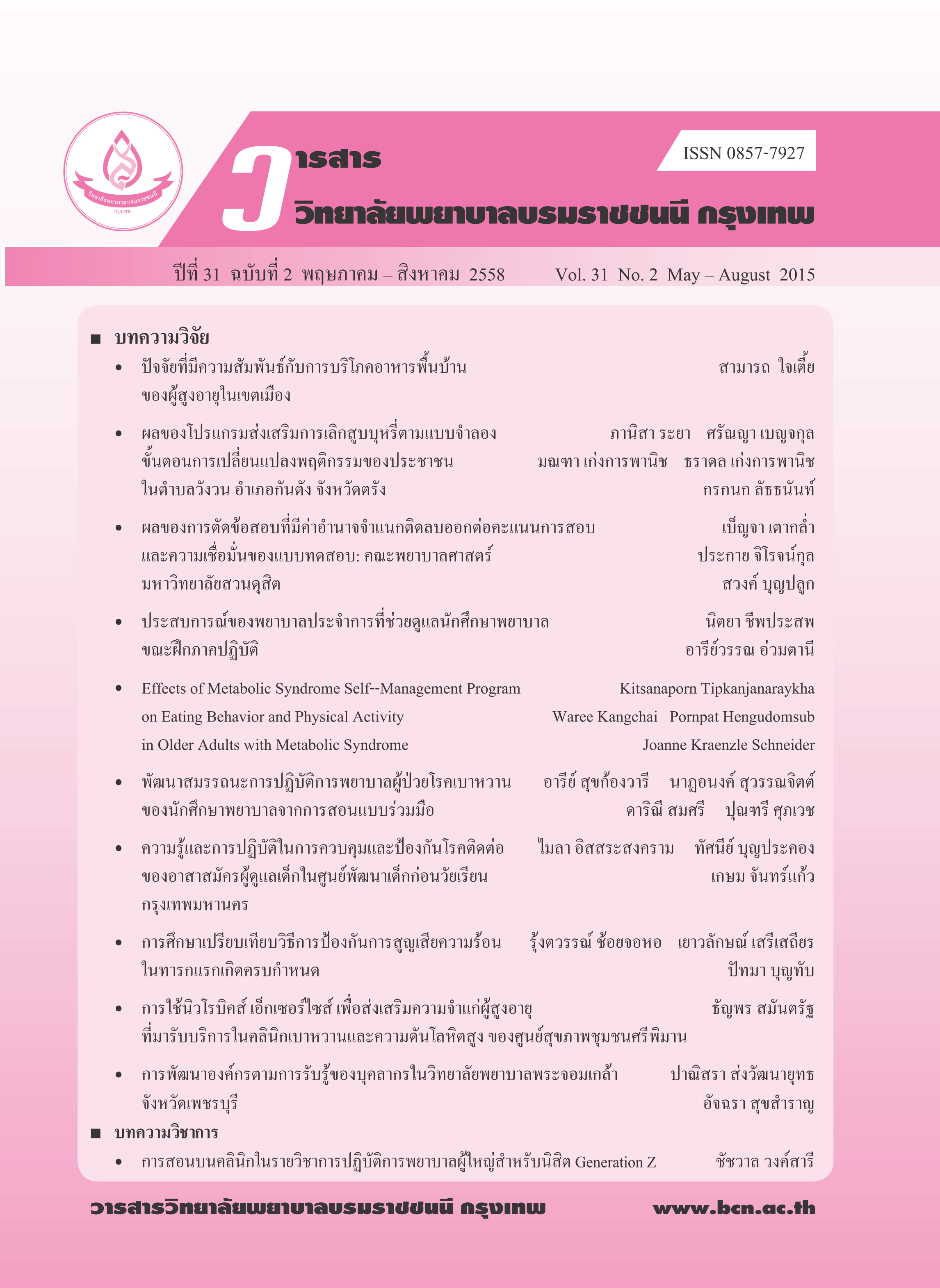การศึกษาเปรียบเทียบวิธีการป้องกันการสูญเสียความร้อนใน ทารกแรกเกิดครบกำหนด A COMPARATIVE STUDY OF HEAT LOSS PREVENTIVE METHOD IN FULL TERM NEWBORN
คำสำคัญ:
วิธีการป้องกันการสูญเสียความร้อน, ทารกแรกเกิดครบกำหนด, heat loss prevention method, full term newbornบทคัดย่อ
บทคัดย่อ
การวิจัยเชิงทดลอง (Randomized control trial) ครั้งนี้มีวัตถุประสงค์เพื่อเปรียบเทียบวิธีป้องกันการสูญเสียความร้อนในทารกแรกเกิดครบกำหนด กลุ่มตัวอย่างเป็นทารกแรกเกิดครบกำหนด เลือกกลุ่มตัวอย่างตามเกณฑ์ที่กำหนด สุ่มแบบง่ายเข้ากลุ่มควบคุม 24 ราย และกลุ่มทดลอง A 23 ราย และกลุ่มทดลอง B 21 ราย รวม 68 ราย เครื่องมือในการดำเนินการวิจัย ได้แก่ ปรอทวัดอุณหภูมิทารก ปรอทวัดอุณหภูมิมารดาหมวกไหมพรม ผ้าห่อตัวทารก ชุดพลาสติก ถุงพลาสติกใส และพลาสติกครอบเตียงทารก เครื่องมือในการเก็บรวบรวมข้อมูล ได้แก่ แบบบันทึกข้อมูลทั่วไปของมารดาและทารก แบบบันทึกอุณหภูมิกายทารก และแบบบันทึกอุณหภูมิสิ่งแวดล้อม วิเคราะห์ข้อมูลโดยใช้สถิติเชิงพรรณนา การทดสอบไคสแควร์ การวิเคราะห์ความแปรปรวนทางเดียว และการวิเคราะห์ความแปรปรวนแบบวัดซ้ำ
ผลการวิจัยพบว่าอุณหภูมิกายเฉลี่ยหลังได้รับการพยาบาล ภายหลังได้รับนมแม่ของทารกแรกเกิดครบกำหนดระหว่างกลุ่มควบคุม กลุ่มทดลอง A และกลุ่มทดลอง B ไม่แตกต่างกันทางสถิติที่ระดับ .05 เมื่อเปรียบเทียบอุณหภูมิกายเฉลี่ยของกลุ่มทดลอง A กลุ่มทดลอง B และกลุ่มควบคุมโดยการวัดซ้ำ 3 ช่วงเวลาคือ หลังคลอด หลังได้รับนมแม่ และแรกรับที่หออภิบาลทารก พบว่า อุณหภูมิกายเฉลี่ยของทารกระหว่างกลุ่มควบคุมและกลุ่มทดลองทั้งสองไม่แตกต่างกันทางสถิติที่ระดับ .05 อุณหภูมิเฉลี่ยของทารกภายในกลุ่มในแต่ละช่วงเวลาที่แตกต่างกันมีความแตกต่างกันอย่างมีนัยสำคัญทางสถิติที่ระดับ .001 และปฏิสัมพันธ์ระหว่างกลุ่มควบคุมและกลุ่มทดลองทั้งสองกลุ่มกับช่วงเวลาวัดที่แตกต่างกันไม่แตกต่างกันทางสถิติที่ระดับ .05
วิธีการป้องกันการสูญเสียความร้อนทั้ง 3 วิธี สามารถป้องกันการสูญเสียความร้อนให้ทารกแรกเกิดครบกำหนด พยาบาลควรเลือกใช้ให้เหมาะสมกับบริบท
Abstract
The objective of this randomized control trial study was to compare three heat loss preventive methodsin full term newborn. The sample was composed of 68 full term newborn, with gestational age at birth ≥ 37 weeks, born in the delivery room, Rajavithi Hospital. The sample was selected based on inclusion criteria and randomly assigned to control group (n= 24), experimental group A (n = 23), and experimental group B (n = 21). Instruments used in this study were: 1) data collection instruments including personal information questionnaire, body temperature record form, environment temperature record form, and 2)intervention instruments comprising electronic thermometer, thermometer, plastic dress, plastic bag, and crib-covered plastic. The data were analyzed by using descriptive statistics, Chi-square, One-way ANOVA and Repeated-measure ANOVA.
The findings revealed that the mean differences of temperature at pretest, posttest among experimental group A, B, and control group were not statistically significant (p >.05). The mean differences of temperature measured at 3 different times (after delivery, after breast-feed, and at admission to a nursery) in between groups were not statistically significantly (p> .05). The mean differences of temperature at 3 different times (after delivery, after breast-feed, and at admission to a nursery) in within group were statistically significantly at the .001 level; and the difference of interaction in between groups by 3 times were not statistically significantly (p > .05).
The findings suggest that these three heat loss prevention methods is effective in preventing hypothermia in full term newborns. The health care providers should select a proper heat loss prevention method for full term newborns based on their context.
Downloads
ดาวน์โหลด
เผยแพร่แล้ว
รูปแบบการอ้างอิง
ฉบับ
ประเภทบทความ
สัญญาอนุญาต
บทความที่ได้รับการตีพิมพ์ เป็นลิขสิทธิ์ของวารสารวิจัยสุขภาพและการพยาบาล (วิทยาลัยพยาบาลบรมราชชนนี กรุงเทพ) ไม่สามารถนำไปตีพิมพ์ซ้ำในวารสารฉบับอื่น


















